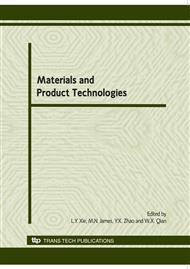p.17
p.27
p.32
p.37
p.43
p.49
p.54
p.59
p.65
The Fracture and Fatigue Behaviour of Nano-Modified SAN
Abstract:
An amorphous styrene-acrylonitrile (SAN) copolymer has been modified by various concentrations of metal oxide (MeO) nano-particles up to 0.50 vol.%. Atomic force microscopy of the modified thermoplastics showed that the nano-particles were well dispersed in the matrix. The incorporation of the nano-particles had a marginal effect on the glass transition temperature and yield stress. However, the Young’s modulus increased with the volume fraction of the nano-particles. The fracture and fatigue properties also had a marked increase with the addition of the nano-particles. The fracture energy was increased from 316±10 J/m2 to 445±27 J/m2, and the maximum fracture energy threshold was increased from 17±1 J/m2 to 34±2 J/m2 at 23 °C. Scanning electron microscopy (SEM) studies showed that debonding of nano-partilces, subesequent plastic void growth and large scale fibril deformation initiated by mulitiple crazing were observed in the process zone of the nano-modified composites.
Info:
Periodical:
Pages:
43-48
Citation:
Online since:
June 2010
Keywords:
Price:
Сopyright:
© 2010 Trans Tech Publications Ltd. All Rights Reserved
Share:
Citation:


